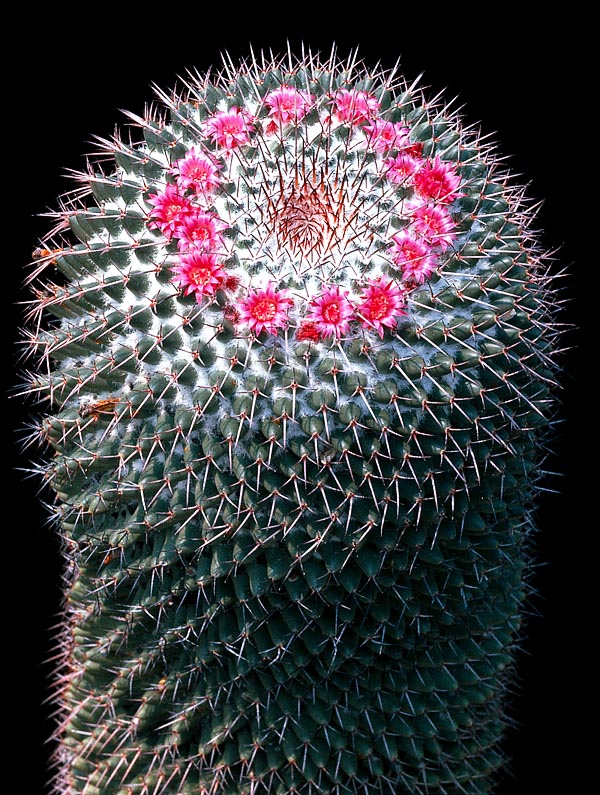Family : Cactaceae

Text © Pietro Puccio

English translation by Mario Beltramini
The Mammillaria polythele Mart. (1832) subsp. polythele is native to central Mexico (states of Guanajuato, Hidalgo and Querétaro), where it grows up to 2600 m of altitude un semi-desert areas characterized by temperate dry climate and prevailingly calcareous soils.
The name of the genus comes from the Latin “mammilla” = nipple, with reference to the tubercles present in these plants; the name of the species is the combination of the Greek words “polys” = much and “thele” = teat, with analogous reference.
Common names: “biznaga de chilitos” (Spanish).
Tufty plant with globose to cylindrical stems, with rounded apex, to about 40 cm high and 6-8 cm in diameter, of green-grey colour; it has 8-10 mm long, spirally placed, pyramidal tubercles, with little white lanugo persisting at their base.
The apical areolae of the tubercles, oval, initially covered by white down, are provided of 4-6 radial thorns, long 5-12 mm of reddish brown colour, darker on the tip, to almost black, which, with the time, becomes paler.

Native to the semi desert central Mexican areas, up to 2600 m of altitude, Mammillaria polythele subsp. polythele reaches 40 cm with 6-8 cm stems. Spiral tubercles and pretty flowers carousels © G. Mazza
The claviform fruits, about 18 mm long, are of reddish colour and contain brown, 1 mm long, pyriform, seeds.
It reproduces by seed and division.
Other two subspecies are recognized:
Mammillaria polythele subsp. durispina (Boed.) D.R. Hunt (1997)
Mammillaria polythele subsp. obconella (Scheidw.) D.R. Hunt (1997)
and five varieties:
Mammillaria polythele var. aciculata (Otto ex Pfeiff.) Salm-Dyck
Mammillaria polythele var. hexacantha Salm-Dyck (1849)
Mammillaria polythele var. latimamma Salm-Dyck (1849)
Mammillaria polythele var. quadrispina (Mart.) Salm-Dyck (1843)
Mammillaria polythele var. setosa (Pfeiff.) Salm-Dyck (1844)
Cactus spread in cultivation, of which are appreciated and sought-after the cultivars almost without thorns and lanugo, to be placed in full sun or slight shade, on particularly draining soils, which can be formed for about the 50% by common garden manure soil and for the rest, in equal quantity, by sand (or agriperlite) and crushed stone without dust.
Little resistant to the low temperatures, as it can stand, if dry and for short period, temperatures as low as -1°C; its best collocation in open air, where the climate allows it, is in the “desert” gardens together with other xerophytes, elsewhere it is to be cultivated in pot with the same modalities said before.
In summer, during the vegetative period, it is to be watered with regularity, but allowing the soil to dry up completely before giving water again, in winter, it is to be kept dry and when the temperatures are rather low, but not less then +5°C, this resting time, cold and dry, is indispensable for getting a good blossoming.
The plant is inscribed in the appendix II of the CITES (plant for which the trade is ruled at international level).
Synonyms: Mammillaria galeottii Scheidw. (1837); Mammillaria tetracantha Salm-Dyck (1837); Mammillaria crocidata Lem. (1838); Mammillaria dolichocentra Lem. (1838); Mammillaria kewensis Salm-Dyck (1849); Cactus polythele (Mart.) Kuntze (1891); Mammillaria hidalgensis Purpus (1907).
